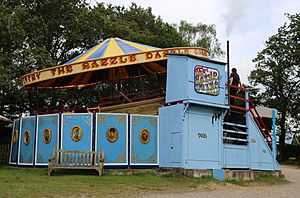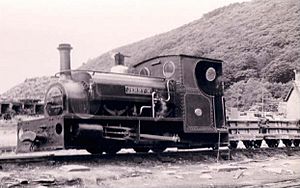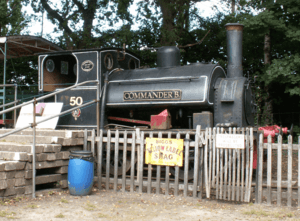Hollycombe Steam Collection facts for kids
The Hollycombe Steam Collection is a special place in South East England. It's filled with amazing machines that run on steam power! You can find old-fashioned fairground rides, a farm with vintage equipment, two railways, and beautiful gardens. Even though it's in West Sussex, the closest town is Liphook in Hampshire.
Contents
How Hollycombe Started
The Vision of John Baldock
The Hollycombe collection began in the late 1940s. A man named Commander John Baldock loved steam engines. These powerful machines were quickly disappearing from everyday life in Britain. He wanted to save them.
By the early 1960s, John Baldock had gathered many steam-powered road vehicles. He then started collecting old fairground rides. In the late 1960s, he also began saving railway equipment.
Opening to the Public
John Baldock's collection became very popular. He opened it to the public, and it grew into a big tourist attraction. However, the collection became so large that it was too much for one person to manage. By 1984, John Baldock thought he might have to close it down.
Volunteers Step In
Luckily, a group of volunteers formed a society to help run the collection. Their efforts were successful, and Hollycombe continued to grow. In 1987, a big storm damaged some parts of the collection, including the bioscope (an early cinema) and the tea room roof. A special steam tractor helped clear the fallen trees.
In 1999, a charitable trust took over running most of the collection. This was made possible with help from a Heritage Lottery Fund grant.
What You Can See at Hollycombe
Edwardian Fairground Rides
The Edwardian Fairground is like stepping back in time! It shows what a steam fair looked like in the 1870s and later. The rides are rotated throughout the year so volunteers can keep them in great shape.
Some of the exciting rides include:
- The Tidman Golden Gallopers, a classic carousel with three rows of horses.
- A unique single steam yacht ride.
- The Razzle Dazzle, a grand ride that spins and tilts.
- S. Fields Steam Circus, built between 1868 and 1872, is the oldest working fairground ride of its kind.
- Steam swings and Walker Chair-o-Planes.
- A big Ferris wheel.
- A Bioscope show, which is an early traveling cinema.
Most of these rides are made of wood and powered by real steam engines. There are rides for all ages, and the fairground organs play music to complete the old-time atmosphere. You can also try your luck at various side stalls.
The Working Farm
The farm area at Hollycombe features many old steam-powered farm machines. You can see ploughing engines, a threshing machine, and a baler. There's also a stationary steam engine that powers smaller machines using a line shaft.
The sawmill on site uses a large Robey steam engine to cut wood. Close by, you can see the engine from the paddle steamer Caledonia.
Exciting Railways
Hollycombe has two working railways:
- A narrow gauge railway: This railway has tracks that are closer together than standard tracks.
- A miniature railway: This is a smaller railway, perfect for a fun ride.
There used to be a third railway with standard gauge tracks, but it is no longer in use.
Miniature Railway Journey
The miniature railway has a track gauge of 7.25 inches. It starts at the station near the sawmill. The train climbs uphill, passes through crossing gates, and goes through a cutting (a dug-out section of land).
At the top, it turns left. You can see the fairground on one side and the woodland gardens on the other. The train then enters another cutting before making a full 360-degree loop onto an embankment. Finally, it runs next to a five-inch gauge line into the two-platform station.
Beautiful Woodland Gardens
The Hollycombe estate has lovely Victorian gardens. John Clarke Hawkshaw planted over a million trees here starting in the 1880s. His son, Oliver Clarke, continued planting in the 1920s, creating a quarter-mile long Azalea Walk. John Baldock also helped manage and develop the gardens from the 1950s onwards.
Steam Engines Galore
The Hollycombe Steam Collection is home to more than 30 different types of steam engines. These amazing machines show how steam power was used for many different jobs in the past.
See also
- British narrow-gauge railways
- List of traction engine manufacturers






